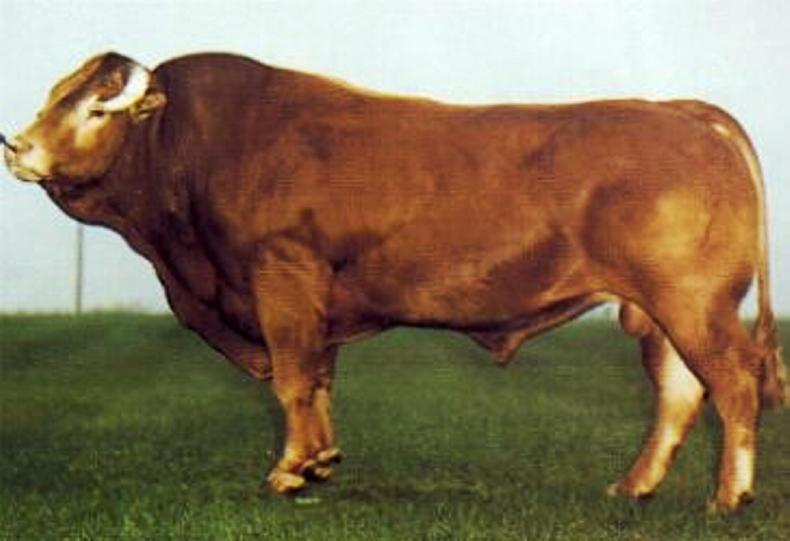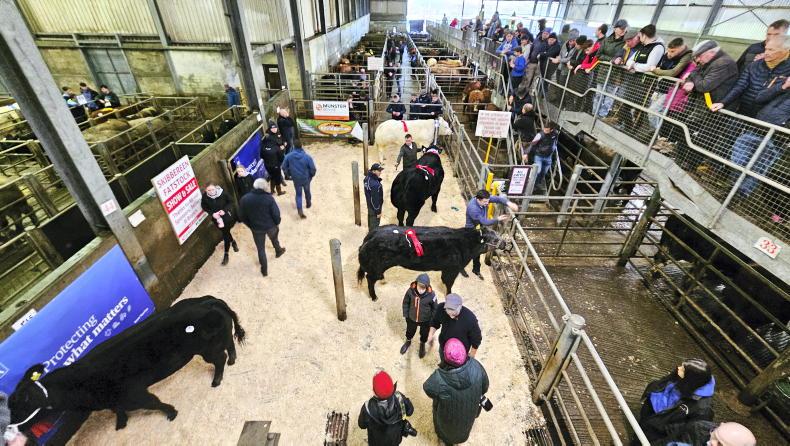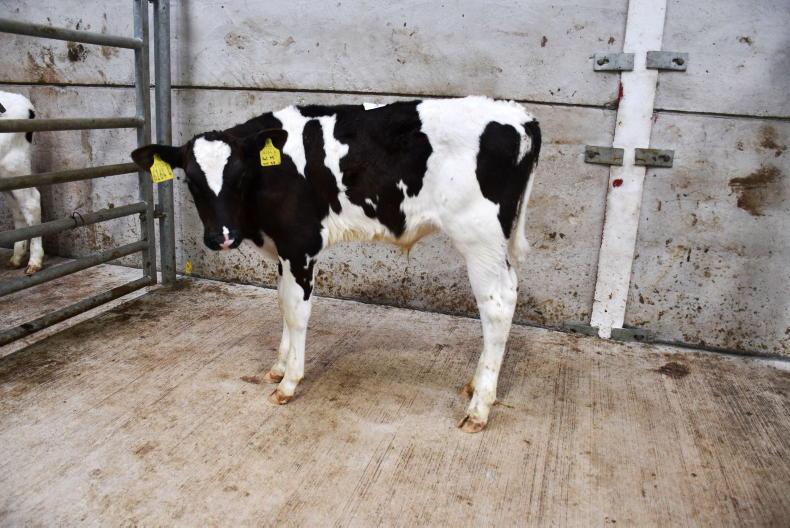There is often frustration especially with pedigree breeders when a bull ends up with a high difficult calving figure. Pat Donellan, ICBF, explains some of the reasons behind the figure.
There are four factors that will both contribute to what calving ease index figure your bull starts out with and also how it changes over time:
Backpedigree.Genotype.Foreign data. Irish data.1
Back pedigree
The first calving ease index that a bull will receive is called a parent average index. As the name suggests, it is an average figure that is calculated from the index figures that his sire and dam have at the time of his birth. If the index figure of a close relative of the bull moves up or down significantly, then this will also affect the index figure of the bull himself.
2
Genotype
When a sample of DNA (eg hair or a straw of semen) is sent off and the genotype comes back, this will then alter the figure that the bull got in his first evaluation run which would have been through his parent average as explained above. So, there could be a difference in a bull’s calving ease from his very first evaluation compared with the one after the genotype has been included.
3
Foreign data
If a bull already has an index for calving ease in another country and this data is sent to ICBF this will also have an effect on shaping his calving ease index in Ireland. ICBF routinely gets files of such index values from countries such as the UK and France.
4
Irish data: the degree of difficulty that the bull’s own calves are born here with is the final piece of the jigsaw in terms of his calving ease index.
Reliability
The number of herds that his progeny have their calving ease recorded in, together with the number of herdmates that were born around the same time, will determine by how much this reliability figure increases.
Highlander is a Limousin AI sire. In terms of steps one to four outlined (left), his backpedigree is in the ICBF database, as is his genotype. He was a widely used bull in France and they sent over his French index data which was included in his Irish calving figure here. He has an index of 108 in France which puts him in the easy calving category in France. That would also have had a positive influence on his easy calving index figure here.
In terms of his Irish data, the calving ease data of his progeny can be seen in the ICBF animal search facility:
Go to www.icbf.com.Go to the Animal Search facility on the right-hand side of the website and enter in “Highlander” (or his AI code “HGR”).Click on “calving ease”, which is shaded in blue.Scroll down to the table that says “sire progeny and progeny herdmate information”.As can be seen from the data in Table 1, the 4,482 calves sired by Highlander that had calving surveys recorded on them had 2% less calving difficulty than their 14,160 herdmates. His calves were also born with very little difficulty on heifers (first parity) and on older cows.
Putting all of these pieces of information together results in Highlander being rated as a very easy-calving bull with a calving ease index of 2.5% in Ireland, across breed, with a 99% reliability rating. The ICBF database is powered by data recorded by Irish farmers and industry partners. This data is converted into genetic indexes by ICBF. Summary tables of this data can be found through the ICBF animal search as described in the example bull above.
John, David and
Mark Finnegan,
Coachford, Co Cork
Pedigree breed: Simmental
Why do you participate in the WHPR programme?
“We operate in Cork under the Leeherd prefix, and have been using WHPR and the “Stockbull Finder” since it started. We have been recording data since the days of the Tully bull intake, so it is an added bonus to have the annual on-farm weighing and inspections to allow us to stand over our own data recording, birth weights and ADGs. We buy a herd sire every two to three years and the last two have been sourced from other WHPR herds.
Have you had bull enquiries through the stockbull finder?
We have found that 50% of all bull enquiries are now coming through it. The visual assessment piece is still important to buyers. They like to see the full herd of cows when they come to visit. They get more comfort in making a purchase when they see the environment that the bull was reared in.
What are your thoughts on the BDGP and BEEP schemes?
We are participants in both. Weight, data recording and genotyping are important if we are to improve the genetic potential of the suckler herd – one just needs to look at the progress made in dairy EBIs over the last 15 years.
There will always be anomalies but accuracy and reliability takes time, and requires widespread recording for quicker progress. However, in relation to BDGP, perhaps it has pushed the dairy cross heifer as a quick fix for increasing star ratings in herds, but she will never produce the quality calf of a straight beef heifer, particularly a dual maternal and terminal breed such as Simmental, where weight recording has shown the breed to be above all others for ADG.
As a beef industry, we need to produce the spec of cattle that the live export market and the beef finisher will compete for, and that is a U grade animal capable of efficiently achieving ADGs and kill-out to leave a margin for both the weanling producer and the finisher. Cattle should be finished younger, which is important when climate change and emissions are becoming key topics. Any future scheme must take all of this into account.
Genotyping can confirm parentage and tell us more about an animal’s genetics. What do you think of it?
Look, genotyping is hugely important for a lot of reasons, but from a pedigree breeder’s perspective alone, parentage verification is a huge thing. Looking at the problems some breeds in other countries have had recently, it only takes one error somewhere to cast doubt on the entire industry.
What are the three most influential AI sires in the Simmental breed, in your opinion?
Let’s keep it Irish. Firstly, Hillcrest Champion was the first truly modern Irish-bred Simmental bull and he helped transform the breed here. He bred super males and females which have had a hugely positive impact both here and in the UK. Anatrim Jacob left outstanding females, which have bred some of the most successful bulls in the last decade, such as Clonagh World Class and Anatrim Bodybuilder.
The number of national champions and sale toppers Raceview King produced, across multiple herds both here and the UK, is phenomenal.
There is often frustration especially with pedigree breeders when a bull ends up with a high difficult calving figure. Pat Donellan, ICBF, explains some of the reasons behind the figure.
There are four factors that will both contribute to what calving ease index figure your bull starts out with and also how it changes over time:
Backpedigree.Genotype.Foreign data. Irish data.1
Back pedigree
The first calving ease index that a bull will receive is called a parent average index. As the name suggests, it is an average figure that is calculated from the index figures that his sire and dam have at the time of his birth. If the index figure of a close relative of the bull moves up or down significantly, then this will also affect the index figure of the bull himself.
2
Genotype
When a sample of DNA (eg hair or a straw of semen) is sent off and the genotype comes back, this will then alter the figure that the bull got in his first evaluation run which would have been through his parent average as explained above. So, there could be a difference in a bull’s calving ease from his very first evaluation compared with the one after the genotype has been included.
3
Foreign data
If a bull already has an index for calving ease in another country and this data is sent to ICBF this will also have an effect on shaping his calving ease index in Ireland. ICBF routinely gets files of such index values from countries such as the UK and France.
4
Irish data: the degree of difficulty that the bull’s own calves are born here with is the final piece of the jigsaw in terms of his calving ease index.
Reliability
The number of herds that his progeny have their calving ease recorded in, together with the number of herdmates that were born around the same time, will determine by how much this reliability figure increases.
Highlander is a Limousin AI sire. In terms of steps one to four outlined (left), his backpedigree is in the ICBF database, as is his genotype. He was a widely used bull in France and they sent over his French index data which was included in his Irish calving figure here. He has an index of 108 in France which puts him in the easy calving category in France. That would also have had a positive influence on his easy calving index figure here.
In terms of his Irish data, the calving ease data of his progeny can be seen in the ICBF animal search facility:
Go to www.icbf.com.Go to the Animal Search facility on the right-hand side of the website and enter in “Highlander” (or his AI code “HGR”).Click on “calving ease”, which is shaded in blue.Scroll down to the table that says “sire progeny and progeny herdmate information”.As can be seen from the data in Table 1, the 4,482 calves sired by Highlander that had calving surveys recorded on them had 2% less calving difficulty than their 14,160 herdmates. His calves were also born with very little difficulty on heifers (first parity) and on older cows.
Putting all of these pieces of information together results in Highlander being rated as a very easy-calving bull with a calving ease index of 2.5% in Ireland, across breed, with a 99% reliability rating. The ICBF database is powered by data recorded by Irish farmers and industry partners. This data is converted into genetic indexes by ICBF. Summary tables of this data can be found through the ICBF animal search as described in the example bull above.
John, David and
Mark Finnegan,
Coachford, Co Cork
Pedigree breed: Simmental
Why do you participate in the WHPR programme?
“We operate in Cork under the Leeherd prefix, and have been using WHPR and the “Stockbull Finder” since it started. We have been recording data since the days of the Tully bull intake, so it is an added bonus to have the annual on-farm weighing and inspections to allow us to stand over our own data recording, birth weights and ADGs. We buy a herd sire every two to three years and the last two have been sourced from other WHPR herds.
Have you had bull enquiries through the stockbull finder?
We have found that 50% of all bull enquiries are now coming through it. The visual assessment piece is still important to buyers. They like to see the full herd of cows when they come to visit. They get more comfort in making a purchase when they see the environment that the bull was reared in.
What are your thoughts on the BDGP and BEEP schemes?
We are participants in both. Weight, data recording and genotyping are important if we are to improve the genetic potential of the suckler herd – one just needs to look at the progress made in dairy EBIs over the last 15 years.
There will always be anomalies but accuracy and reliability takes time, and requires widespread recording for quicker progress. However, in relation to BDGP, perhaps it has pushed the dairy cross heifer as a quick fix for increasing star ratings in herds, but she will never produce the quality calf of a straight beef heifer, particularly a dual maternal and terminal breed such as Simmental, where weight recording has shown the breed to be above all others for ADG.
As a beef industry, we need to produce the spec of cattle that the live export market and the beef finisher will compete for, and that is a U grade animal capable of efficiently achieving ADGs and kill-out to leave a margin for both the weanling producer and the finisher. Cattle should be finished younger, which is important when climate change and emissions are becoming key topics. Any future scheme must take all of this into account.
Genotyping can confirm parentage and tell us more about an animal’s genetics. What do you think of it?
Look, genotyping is hugely important for a lot of reasons, but from a pedigree breeder’s perspective alone, parentage verification is a huge thing. Looking at the problems some breeds in other countries have had recently, it only takes one error somewhere to cast doubt on the entire industry.
What are the three most influential AI sires in the Simmental breed, in your opinion?
Let’s keep it Irish. Firstly, Hillcrest Champion was the first truly modern Irish-bred Simmental bull and he helped transform the breed here. He bred super males and females which have had a hugely positive impact both here and in the UK. Anatrim Jacob left outstanding females, which have bred some of the most successful bulls in the last decade, such as Clonagh World Class and Anatrim Bodybuilder.
The number of national champions and sale toppers Raceview King produced, across multiple herds both here and the UK, is phenomenal.










SHARING OPTIONS